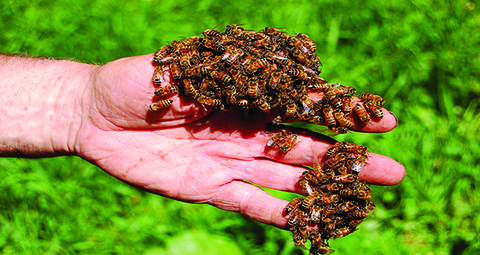Is that a bee-sting in your pocket, or are you just pleased to see me?
26 Oct 2015 by Evoluted New Media

Rarely is physical suffering a suitable topic for a whimsical column like Science Lite. The wry lens through which we attempt to view certain aspects of science can’t really be focussed on pain, not justifiably at least.
Rarely is physical suffering a suitable topic for a whimsical column like Science Lite. The wry lens through which we attempt to view certain aspects of science can’t really be focussed on pain, not justifiably at least.
But, ever the journalistic adventurers (…or, should that be, charlatans) we think we have found a way. You’ll find it of some relief perhaps to know that the source of this comes from The 2015 Ig Nobel Prizes. Set-up 25 years ago, the Igs aim to honour achievements that first make people laugh, and then make them think.
Held at Harvard University’s historic Sanders Theatre before 1100 spectators, the awards this year went to some truly spectacular research. Dinosaur-esque chickens, un-boiling an egg and a mammalian urination constant– just some of the highlights. And we will get to those, but first we think a special mention needs to go to the Michael L. Smith, joint winner of the Physiology and Entomology prize.
Michael, a 4th year graduate student in the Department of Neurobiology and Behaviour at Cornell University in the US, is an expert on honey bees. In his paper (published in PeerJ here: https://peerj.com/articles/338/) he asks a simple question: If bee sting location is important in pain perception, how important is it?
So far so ordinary. Yet there is something you need to know about Michael. He clearly is of the mind that observation and measurement are sometimes not enough to push scientific enquiry forward.
Occasionally only experience – actual personal exposure – will do. As such he won his Ig for carefully arranging honey bees to sting him repeatedly on 25 different locations on his body.
How, you may be thinking, does one go about arranging for stings to be applied in such a controlled manner? Michael, over to you: “Bees were taken from the cage haphazardly with forceps. To apply the sting, the bee was grabbed by the wings and pressed against the desired sting location. The bee was held against the sting location until the sting was first felt, and kept at the location for 5 seconds to ensure that the stinger would penetrate the skin.”
In total, an eye-watering three full stinging rounds were conducted, over a total of 38 days. Mensis horribilis anyone?
So, after such toil, what did he find? Well, the least painful parts of the body to receive a honey bee sting turn-out to be the skull, middle toe tip, and upper arm, with the most painful being the nostril, upper lip, and – it pains us even to write this – the penis shaft. That’s right; Michael held a bee against his penis until it stung. He also tested his nipple, buttox and scrotum – which surprisingly didn’t make the top three most painful areas.
If nothing else this must mean he has the most intimate knowledge of honey bee behaviour yet gained by a human. And by some margin. Michael we salute you – although perhaps a more practical honour would be to send you some hydrocortisone cream.
As for the rest, all spectacular in their own way, here is a quick breakdown:
Physics Prize – Patricia Yang, David Hu Jonathan Pham and Jerome Choo for testing the biological principle that nearly all mammals empty their bladders in about 21 seconds (plus or minus 13 seconds).
Diagnostic Medicine Prize – Diallah Karim, Anthony Harnden, Nigel D’Souza, Andrew Huang, Abdel Kader Allouni, Helen Ashdown, Richard J. Stevens, and Simon Kreckler, for determining that acute appendicitis can be accurately diagnosed by the amount of pain evident when the patient is driven over speed bumps.
Chemistry Prize – Callum Ormonde and Colin Raston, and Tom Yuan, Stephan Kudlacek, Sameeran Kunche, Joshua N. Smith, William A. Brown, Kaitlin Pugliese, Tivoli Olsen, Mariam Iftikhar, Gregory Weiss, for inventing a chemical recipe to partially un-boil an egg.
Biology Prize – Bruno Grossi, Omar Larach, Mauricio Canals, Rodrigo A. Vásquez, José Iriarte-Díaz, for observing that when you attach a weighted stick to the rear end of a chicken, the chicken then walks in a manner similar to that in which dinosaurs are thought to have walked.

